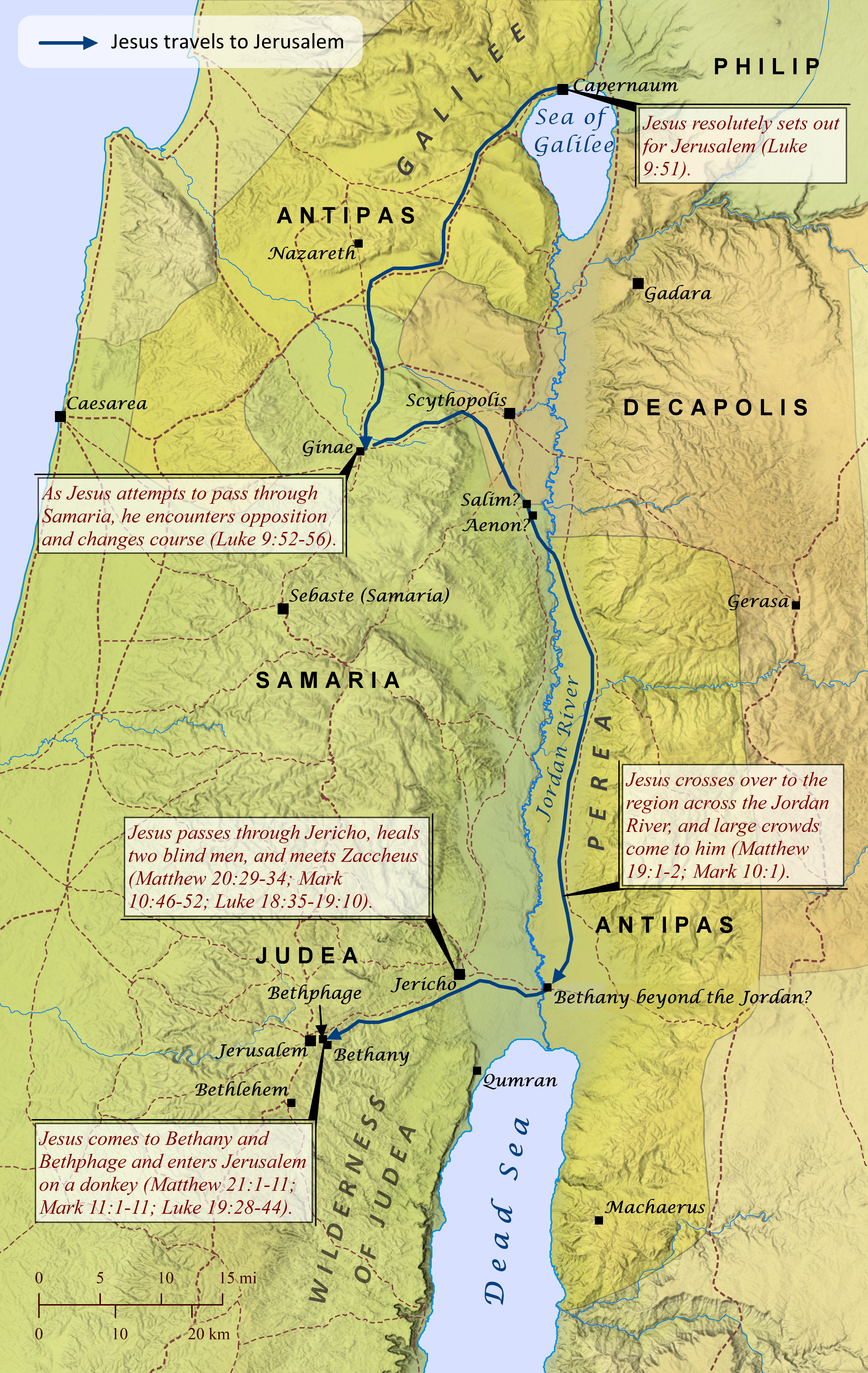Note: This view shows ‘verses’ which are not natural language units and hence sometimes only part of a sentence will be visible—click on any Bible version abbreviation down the left-hand side to see the verse in more of its context. Normally the OET discourages the reading of individual ‘verses’, but this view is only designed as a tool for doing comparisons of different translations—the older translations are further down the page (so you can read up from the bottom to trace the English translation history). The OET segments on this page are still very early looks into the unfinished texts of the Open English Translation of the Bible—please double-check these texts in advance before using in public.
AICNT And Jesus, moved with compassion, touched their eyes, and immediately {they regained their sight and followed him}.[fn]
OEB So Jesus, moved with compassion, touched their eyes, and immediately they recovered their sight, and followed him.
WEBBE Jesus, being moved with compassion, touched their eyes; and immediately their eyes received their sight, and they followed him.
WMBB Yeshua, being moved with compassion, touched their eyes; and immediately their eyes received their sight, and they followed him.
NET Moved with compassion, Jesus touched their eyes. Immediately they received their sight and followed him.
LSV and having been moved with compassion, Jesus touched their eyes, and immediately their eyes received sight, and they followed Him.
FBV Jesus had pity on them and touched their eyes. Immediately they could see, and they followed him.
TCNT Moved with compassion, Jesus touched their eyes, and immediately [fn]their eyes received sight, and they followed him.
T4T Jesus felt sorry for them and touched their eyes. Immediately they were able to see, and they went with Jesus.
LEB And having compassion, Jesus touched their eyes, and immediately they received their sight and followed him.
BBE And Jesus, being moved with pity, put his fingers on their eyes: and straight away they were able to see, and went after him.
Moff Then Jesus in pity touched their eyes, and they regained their sight at once and followed him.
Wymth Moved with compassion, Jesus touched their eyes, and immediately they regained their sight and followed Him.
¶
ASV And Jesus, being moved with compassion, touched their eyes; and straightway they received their sight, and followed him.
DRA And Jesus having compassion on them, touched their eyes. And immediately they saw, and followed him.
YLT and having been moved with compassion, Jesus touched their eyes, and immediately their eyes received sight, and they followed him.
Drby And Jesus, moved with compassion, touched their eyes; and immediately their eyes had sight restored to them, and they followed him.
RV And Jesus, being moved with compassion, touched their eyes: and straightway they received their sight, and followed him.
SLT And Jesus, having felt compassion, touched their eyes: and quickly their eyes looked up, and they followed him.
Wbstr So Jesus had compassion on them , and touched their eyes: and immediately their eyes received sight, and they followed him.
KJB-1769 So Jesus had compassion on them, and touched their eyes: and immediately their eyes received sight, and they followed him.
KJB-1611 So Iesus had compassion on them, and touched their eyes: and immediatly their eyes receiued sight, and they followed him.
(Modernised spelling is same as from KJB-1769 above)
Bshps So Iesus had compassion on them, and touched their eyes: and immediatly theyr eyes receaued syght. And they folowed hym.
(Modernised spelling is same as from KJB-1769 above, apart from marking of added words (and possibly capitalisation and punctuation))
Gnva And Iesus mooued with compassion, touched their eyes, and immediatly their eyes receiued sight, and they followed him.
(And Yesus/Yeshua moved with compassion, touched their eyes, and immediately their eyes received sight, and they followed him. )
Cvdl And Iesus had compassion vpon them, and touched their eyes: & immediatly their eies receaued sight. And they folowed him.
(And Yesus/Yeshua had compassion upon them, and touched their eyes: and immediately their eyes received sight. And they followed him.)
TNT Iesus had compassion on the and touched their eyes. And immediatly their eyes receaved syght. And they folowed him.
(Yesus/Yeshua had compassion on the and touched their eyes. And immediately their eyes received sight. And they followed him. )
Wycl And Jhesus hadde merci on hem, and touchide her iyen; and anoon thei sayen, and sueden him.
(And Yhesus had mercy on them, and touched her eyes; and anon/immediately they sayen, and followed him.)
Luth Und es jammerte JEsum und rührete ihre Augen an. Und alsbald wurden ihre Augen wieder sehend, und sie folgten ihm nach.
(And it yammerte Yesum and stirs/moves/touchese their/her eyes at/to. And soon became their/her eyes again seed, and they/she/them folgten him after.)
ClVg Misertus autem eorum Jesus, tetigit oculos eorum. Et confestim viderunt, et secuti sunt eum.
(Misertus however their Yesus, tetigit the_eyes their. And confestim they_saw, and followed are him. )
UGNT σπλαγχνισθεὶς δὲ, ὁ Ἰησοῦς ἥψατο τῶν ὀφθαλμῶν αὐτῶν, καὶ εὐθέως ἀνέβλεψαν καὶ ἠκολούθησαν αὐτῷ.
(splagⱪnistheis de, ho Yaʸsous haʸpsato tōn ofthalmōn autōn, kai eutheōs aneblepsan kai aʸkolouthaʸsan autōi.)
SBL-GNT σπλαγχνισθεὶς δὲ ὁ Ἰησοῦς ἥψατο τῶν ⸀ὀμμάτων αὐτῶν, καὶ εὐθέως ⸀ἀνέβλεψαν καὶ ἠκολούθησαν αὐτῷ.
(splagⱪnistheis de ho Yaʸsous haʸpsato tōn ⸀ommatōn autōn, kai eutheōs ⸀aneblepsan kai aʸkolouthaʸsan autōi.)
RP-GNT Σπλαγχνισθεὶς δὲ ὁ Ἰησοῦς ἥψατο τῶν ὀφθαλμῶν αὐτῶν· καὶ εὐθέως ἀνέβλεψαν αὐτῶν οἱ ὀφθαλμοί, καὶ ἠκολούθησαν αὐτῷ.
(Splagⱪnistheis de ho Yaʸsous haʸpsato tōn ofthalmōn autōn; kai eutheōs aneblepsan autōn hoi ofthalmoi, kai aʸkolouthaʸsan autōi.)
TC-GNT Σπλαγχνισθεὶς δὲ ὁ Ἰησοῦς ἥψατο τῶν [fn]ὀφθαλμῶν αὐτῶν· καὶ εὐθέως ἀνέβλεψαν [fn]αὐτῶν οἱ ὀφθαλμοί, καὶ ἠκολούθησαν αὐτῷ.
(Splagⱪnistheis de ho Yaʸsous haʸpsato tōn ofthalmōn autōn; kai eutheōs aneblepsan autōn hoi ofthalmoi, kai aʸkolouthaʸsan autōi. )
Key for above GNTs: yellow:punctuation differs, red:words differ (from our SR-GNT base).
